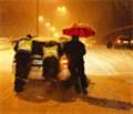Washington Drivers: The Right Way to Abandon Your Car in a Snow Storm
 |
PEMCO Insurance offers tips on what to do when you must leave your car
SEATTLE, Jan. 28 -- As Western Washington braces for another possible snowstorm tonight and tomorrow morning, some drivers will again prove they're a little bit different from their Eastern Washington counterparts: they'll take the risky step of abandoning their vehicles, unable to maneuver through the ice and snow.
According to PEMCO Insurance, one of Washington's largest auto insurers, drivers should know there's a right way -- and a wrong way -- to abandon a vehicle when weather conditions dictate.
Jon Osterberg, PEMCO spokesperson, recommends that people inexperienced at driving in snow and ice avoid the problem by staying off the roads during winter storms. "Drivers should decide whether they need to be on the road in the first place. But we recognize there are times when the weather turns quickly and circumstances demand that you must drive."
When a driver becomes stranded on the road, PEMCO suggests staying with the car if you safely can. "If there's a chance a tow truck or other help is coming, stay with your vehicle. Leaving it in the roadway presents many risks," Osterberg said.
For example, if drivers leave their vehicle on a route that's usually kept open for emergency traffic, it can be towed, especially if it presents a danger to other drivers.
"Towing charges can be steep, and abandoned-car towing fees typically aren't covered by insurance," he said.
Abandoned cars also run a higher risk of being involved in hit-and-run collisions in snowy weather. Heavy snowfall can obscure a car or place it where others are likely to slide into it. According to Osterberg, hit-and-run damage typically subjects drivers to a higher deductible when the car is repaired.
PEMCO recommends the following tips for drivers who must abandon their vehicle:
-- Try to get as far off the traveled roadway as you safely can.
-- Turn on your flashers, and leave them on. A dead battery is better
than causing an accident for which you could be held responsible.
-- Set out flares to warn other drivers, if you can safely do so.
-- Make a reasoned judgment about whether to remain with the vehicle and
call for help, or to strike out on your own. Some factors to consider
are your health, clothing for the weather, distance to the nearest
help, and likelihood of your vehicle being hit while you're inside it.
-- Leave a note in the window with your contact information. That
improves your chance of hearing from someone who hits your vehicle, or
from the authorities.
-- Take your most valuable items with you.
-- Be sure to remove personal information that could allow a thief to
locate your home and loved ones, steal your identity, or otherwise
defraud you.
-- Secure the vehicle by setting the emergency brake and locking the
doors. Professional towing companies know how to safely tow your
vehicle.
-- You can prevent having to abandon a vehicle by monitoring the weather
before a storm hits. But if you're unavoidably caught in a snowstorm,
be prepared. Proper snow tires and/or chains will help you maneuver
through snow and ice. Keep emergency winter clothes and supplies in
your vehicle to buy you time and protection.
People from colder climates often marvel at how even light snowfall can paralyze Western Washington motorists, closing schools and businesses. Osterberg acknowledges the perception that native drivers are timid, but notes several factors differentiate Seattle snowstorms from those found elsewhere:
-- Seattle-area motorists generally have limited snow-driving skills
compared with drivers elsewhere, because of little experience and
infrequent practice. That results in spinouts and abandoned vehicles.
-- Unlike in colder climates, such as across the Cascades and points
eastward, snow often falls at around 32-34 degrees near Seattle. The
result is wet, slippery snow that's harder to drive on than cold, dry
snow.
-- The Seattle area has many hills, making snow driving inherently
tricky.
-- Because it's surrounded by water, the Seattle area has many roadway
bottlenecks that become worse in snow.
-- Infrequent snowfall = less snow-removal equipment in Western
Washington.
"Add those up, and it's a recipe for gridlock during Seattle snowstorms," said Osterberg.
About PEMCO Insurance
PEMCO Insurance, established in 1949, is a Seattle-based provider of auto, home, boat, life, and umbrella insurance to Washington state residents. PEMCO Insurance is sold by community agents throughout the state and through PEMCO offices. For more information, visit http://www.pemco.com/.


